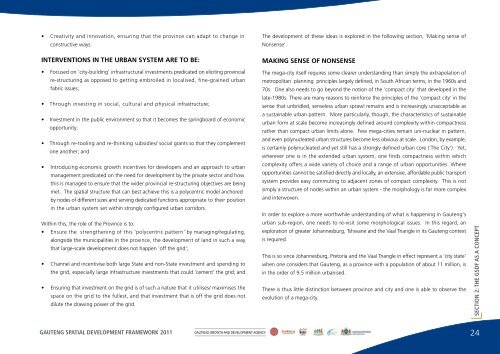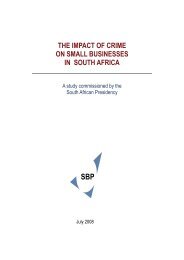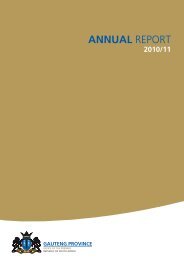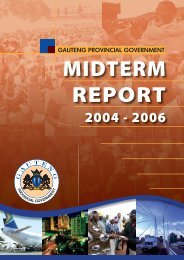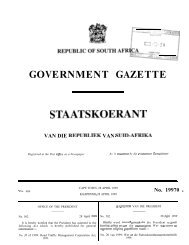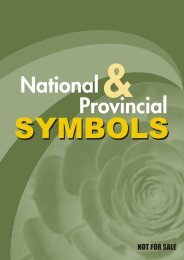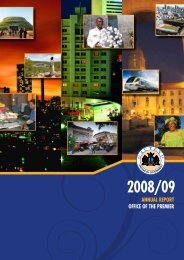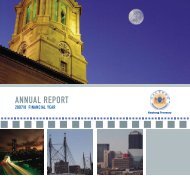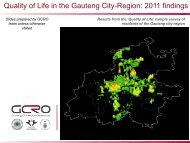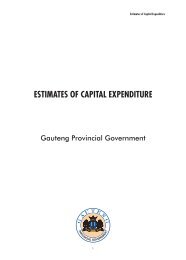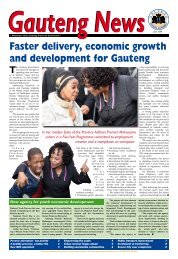the gauteng spatial development framework - Gauteng Online
the gauteng spatial development framework - Gauteng Online
the gauteng spatial development framework - Gauteng Online
Create successful ePaper yourself
Turn your PDF publications into a flip-book with our unique Google optimized e-Paper software.
• Creativity and innovation, ensuring that <strong>the</strong> province can adapt to change inconstructive ways.The <strong>development</strong> of <strong>the</strong>se ideas is explored in <strong>the</strong> following section, 'Making sense ofNonsense'.INTERVENTIONS IN THE URBAN SYSTEM ARE TO BE:MAKING SENSE OF NONSENSE• Focused on 'city-building' infrastructural investments predicated on eliciting provincialre-structuring as opposed to getting embroiled in localised, fine-grained urbanfabric issues;• Through investing in social, cultural and physical infrastructure;• Investment in <strong>the</strong> public environment so that it becomes <strong>the</strong> springboard of economicopportunity;• Through re-tooling and re-thinking subsidies/ social grants so that <strong>the</strong>y complementone ano<strong>the</strong>r; and• Introducing economic growth incentives for developers and an approach to urbanmanagement predicated on <strong>the</strong> need for <strong>development</strong> by <strong>the</strong> private sector and howthis is managed to ensure that <strong>the</strong> wider provincial re-structuring objectives are beingmet. The <strong>spatial</strong> structure that can best achieve this is a polycentric model anchoredby nodes of different sizes and serving dedicated functions appropriate to <strong>the</strong>ir positionin <strong>the</strong> urban system set within strongly configured urban corridors.Within this, <strong>the</strong> role of <strong>the</strong> Province is to:• Ensure <strong>the</strong> streng<strong>the</strong>ning of this 'polycentric pattern' by managing/regulating,alongside <strong>the</strong> municipalities in <strong>the</strong> province, <strong>the</strong> <strong>development</strong> of land in such a waythat large-scale <strong>development</strong> does not happen 'off <strong>the</strong> grid';• Channel and incentivise both large State and non-State investment and spending to<strong>the</strong> grid, especially large infrastructure investments that could 'cement' <strong>the</strong> grid; and• Ensuring that investment on <strong>the</strong> grid is of such a nature that it utilises/ maximises <strong>the</strong>space on <strong>the</strong> grid to <strong>the</strong> fullest, and that investment that is off <strong>the</strong> grid does notdilute <strong>the</strong> drawing power of <strong>the</strong> grid.The mega-city itself requires some clearer understanding than simply <strong>the</strong> extrapolation ofmetropolitan planning principles largely defined, in South African terms, in <strong>the</strong> 1960s and70s. One also needs to go beyond <strong>the</strong> notion of <strong>the</strong> 'compact city' that developed in <strong>the</strong>late-1980s. There are many reasons to reinforce <strong>the</strong> principles of <strong>the</strong> 'compact city' in <strong>the</strong>sense that unbridled, senseless urban sprawl remains and is increasingly unacceptable asa sustainable urban pattern. More particularly, though, <strong>the</strong> characteristics of sustainableurban form at scale become increasingly defined around complexity within compactnessra<strong>the</strong>r than compact urban limits alone. Few mega-cities remain uni-nuclear in pattern,and even polynucleated urban structures become less obvious at scale. London, by example,is certainly polynucleated and yet still has a strongly defined urban core ('The City'). Yet,wherever one is in <strong>the</strong> extended urban system, one finds compactness within whichcomplexity offers a wide variety of choice and a range of urban opportunities. Whereopportunities cannot be satisfied directly and locally, an extensive, affordable public transportsystem provides easy commuting to adjacent zones of compact complexity. This is notsimply a structure of nodes within an urban system - <strong>the</strong> morphology is far more complexand interwoven.In order to explore a more worthwhile understanding of what is happening in <strong>Gauteng</strong>'surban sub-region, one needs to re-visit some morphological issues. In this regard, anexploration of greater Johannesburg, Tshwane and <strong>the</strong> Vaal Triangle in its <strong>Gauteng</strong> contextis required.This is so since Johannesburg, Pretoria and <strong>the</strong> Vaal Triangle in effect represent a 'city state'when one considers that <strong>Gauteng</strong>, as a province with a population of about 11 million, isin <strong>the</strong> order of 9.5 million urbanised.There is thus little distinction between province and city and one is able to observe <strong>the</strong>evolution of a mega-city.SECTION 2: THE GSDF AS A CONCEPTGAUTENG SPATIAL DEVELOPMENT FRAMEWORK 2011GAUTENG GROWTH AND DEVELOPMENT AGENCY24


